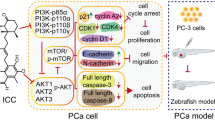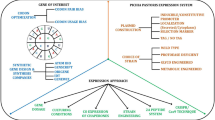Abstract
The ribosomal protein L22 (RPL22) protein belongs to the L22E family of ribosomal proteins. It is located in the cytoplasm. The purpose of this paper was to explore the structure and anti-cancer function of RPL22 of the Giant Panda (Ailuropoda melanoleuca). The cDNA of RPL22 was cloned successfully from the Giant Panda using RT-PCR technology. We constructed a recombinant expression vector containing RPL22 cDNA and over-expressed it in Escherichia coli using pET28a plasmids. The expression product obtained was purified by using Ni chelating affinity chromatography. The result indicated that the length of the fragment cloned is 414 bp, and it contains an open-reading frame of 387 bp encoding 128 amino acids. Primary structure analysis revealed that the molecular weight of the putative RPL22 protein is 14.74 kDa with a theoretical pI 9.21. The RPL22 gene can be really expressed in E. coli and the RPL22 protein, fusioned with the N-terminally His-tagged protein, gave rise to the accumulation of an expected 20.1 kDa polypeptide. The data showed that the recombinant protein RPL22 had a time- and dose-dependency on the cell growth inhibition rate. The human laryngeal carcinoma Hep-2 cells treated with 0.05–6 μg/ml of RPL22 for 24 h displayed significant cell growth inhibition (p < 0.05, n = 8) in assayed using MTT compared to the control (untreated) cells. The data indicate that the effect at low concentrations is better than high concentrations, and the concentration of 1.5 μg/ml has the best rate of growth inhibition of 47.70 %. The inhibitory rate in mice treated with 1.5 μg/ml RPL22 protein can reach 43.75 %. Histology of tumor organs shows that the tissues arranged looser in RPL22 group than those in control group. Meanwhile, there is no obvious damage to other organs, such as heart, lung and kidney. Further research is on going to determine the bioactive principle(s) of recombinant protein RPL22 responsible for its anticancer activity.






Similar content being viewed by others
References
Wool IG, Chan YL, Glück A (1996) Structure and evolution of mammalian ribosomal proteins. Biochem Cell Biol 73:933–947
Wool IG (1996) Extraribosomal functions of ribosomal proteins. Trend Biochem Sci 21:164–165
Fabijanski S, Pellegrini MM (1981) Identification of proteins at the peptidyl-tRNA binding site of rat liver ribosomes. Mole Gen Genet MGG 184:551–556
Nissen P, Hansen J, Ban N, Moore PB, Steitz TA (2000) The structural basis of ribosome activity in peptide bond synthesis. Science 289:920–930
Wang Q, Yang C, Zhou J, Wang X, Wu M, Liu Z (2001) Cloning and characterization of full-length human ribosomal protein L15 cDNA which was overexpressed in esophageal cancer. Gene 263:205–209
Kim JH, You KR, Kim IH, Cho BH, Kim CY, Kim DG (2004) Over-expression of the ribosomal protein L36a gene is associated with cellular proliferation in hepatocellular carcinoma. Hepatology 39:129–138
Lopez CD, Martinovsky G, Naumovski L (2002) Inhibition of cell death by ribosomal protein L35a. Cancer Lett 180:195–202
Yang F, Liu WP (2005) Study on the relation of ribosomal protein gene and human diseases. Chin J Clin Exp Pathol 3:354–356
Klein DJ, Moore PB, Steitz TA (2004) The roles of ribosomal proteins in the structure assembly, and evolution of the large ribosomal subunit. J Mol Biol 340:141–177
Liao MJ, Zhu MY, Zhang ZH, Zhang AJ (2003) cDNA cloning of growth hormone from giant panda (Ailuropoda melanoleuca) and its expression in Escherichia coli. Comp Biochem Phys B 135:109–116
Du YJ, Luo XY, Hao YZ, Zhang T, Hou WR (2007) Cloning and overexpression of acidic ribosomal phosphoprotein P1 gene (RPLP1) from the Giant Panda. Int J Biol Sci 3:428–433
Hou WR, Du YJ, Chen Y, Wu X, Peng ZS, Yang J, Zhou CQ (2007) Nucleotide sequence of cDNA encoding the mitochondrial precursor protein of the ATPase inhibitor from the Giant Panda (Ailuropoda melanoleuca). DNA Cell Biol 26:799–802
Du YJ, Hou WR, Peng ZS, Zhou CQ (2008) cDNA cloning and sequences analysis of acidic ribosomal phosphoprotein P1 (RPLP1) from Giant Panda. Acta Theriologica Sinica 28:75–80
Wu GF, Hou YL, Hou WR, Song Y, Zhang T (2010) Giant panda ribosomal protein S14: cDNA, genomic sequence cloning, sequence analysis, and overexpression. Genet Mol Res 9(4):2004–2015
Hou WR, Luo XY, Du YJ, Chen Y, Wu X, Peng ZS, Yang J, Zhou CQ (2008) cDNA cloning and sequences analysis of RPS15 from the Giant Panda. Recent Pat DNA Seq 2:16–19
Hou YL, Hou WR, Ren ZL, Hao YZ, Zhang T (2009) cDNA cloning and overexpression of ribosomal protein S19 gene (RPS19) from the Giant Panda. Cell Biol 1:1–47
Sun B, Hou YL, Hou WR, Zhang SN, Ding X, Su XL (2012) cDNA cloning, overexpression, purification and pharmacologic evaluation for anticancer activity of ribosomal protein L23A Gene (RPL23A) from the Giant Panda. Int J Mol Sci 13:2133–2147
Nutting CM, Robinson M, Birchall M (2008) Survival from laryngeal cancer in England and Wales up to 2001. Br J Cancer 99:38–39
Zhou J, Callapina M, Goodall GJ, Brune B (2004) Functional integrity of nuclear factor kappaB, phosphatidylinositol 30-kinase, and mitogen-activated protein kinase signaling allows tumor necrosis factor alpha-evoked Bcl-2 expression to provoke internal ribosome entry site-dependent translation of hypoxiainducible factor 1 alpha. Cancer Res 64:9041–9048
Lai MD, Xu J (2007) Ribosomal proteins and colorectal cancer. Curr Genomics 8:43–49
Cheng Q, Lau WM, Chew SH, Ho TH, Tay SK, Hui KM (2002) Identification of molecular markers for the early detection of human squamous cell carcinoma of the uterine cervix. Br J Cancer 86:274–281
Henry JL, Coggin DL, King CR (1993) High-level expression of the ribosomal protein L19 in human breast tumors that overexpress erbB-2. Cancer Res 15:1403–1408
Jemal A, Bray F, Center MM, Ferlay J, Ward E, Forman D (2011) Global cancer statistics. CA Cancer J Clin 61(2):69–90
Tolar J, Neglia JP (2003) Transplacental and other routes of cancer transmission between individuals. J Pediatr Hematol Oncol 25(6):430–434
Yu L, Li HZ, Lu SM, Liu WW, Li JF, Wang HB, Xu W (2009) Alteration in TWIST expression: possible role in paclitaxel-induced apoptosis in human laryngeal carcinoma Hep-2 cell line. Croat Med J 50:536–542
Chiao PJ, Shin DM, Sacks PG, Hong WK, Tainsky MA (1992) Elevated expression of the ribosomal protein S2 gene in human tumors. Mol Carcinog 5:219–231
Barnard GF, Staniunas RJ, Bao S et al (1992) Increased expression of human ribosomal phosphoprotein P0 messenger RNA in hepatocellular carcinoma and colon carcinoma. Cancer Res 52:3067–3072
Deni MG, Chadeneau C, Lecabellec MT et al (1993) Overexpression of the S13 ribosomal protein in actively growing cells. Int J Cancer 55:275–280
Ropolo M, Geroldi A, Rossi O, Degan P, Zupo S, Poggi A, Frosina G (2004) Expression of the Drosophila melanogaster S3 ribosomal/repair protein in T24 human bladder cells. Anticancer Res 24:3811–3818
Clark DE, Errington TM, Smith JA, Frierson HF, Weber MJ, Lannigan DA (2005) The serine/threonine protein kinase, p90 ribosomal S6 kinase, is an important regulator of prostate cancer cell proliferation. Cancer Res 65:3108–3116
Acknowledgments
This project was supported by Application Foundation Project of Sichuan Province (2013JY0094), National Natural Science Foundation of China (31200012) and Doctor Startup Foundation Project of China West Normal University (11B019) and (11B020).
Author information
Authors and Affiliations
Corresponding author
Additional information
Jian Li and Yiling Hou are co-first authors.
Rights and permissions
About this article
Cite this article
Li, J., Hou, Y., Ding, X. et al. Overexpression, purification, molecular characterization and the effect on tumor growth of ribosomal protein L22 from the Giant Panda (Ailuropoda melanoleuca). Mol Biol Rep 41, 3529–3539 (2014). https://doi.org/10.1007/s11033-014-3217-3
Received:
Accepted:
Published:
Issue Date:
DOI: https://doi.org/10.1007/s11033-014-3217-3




